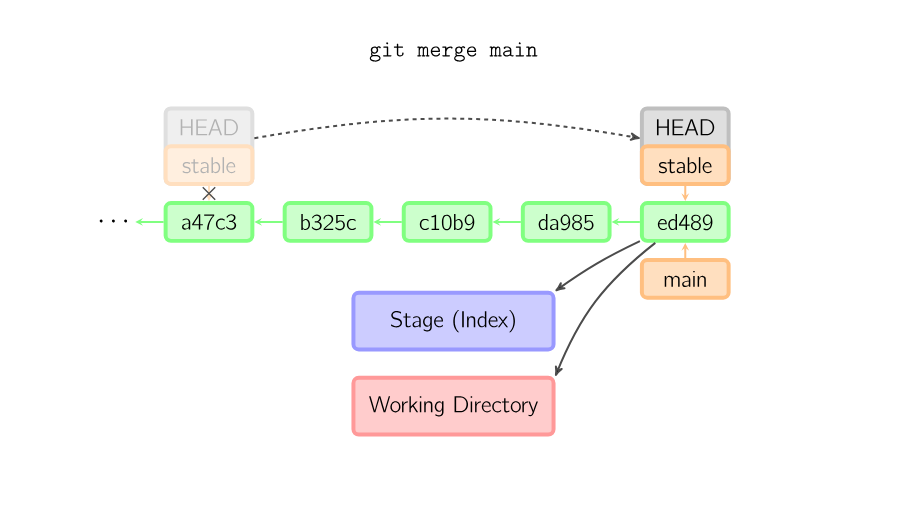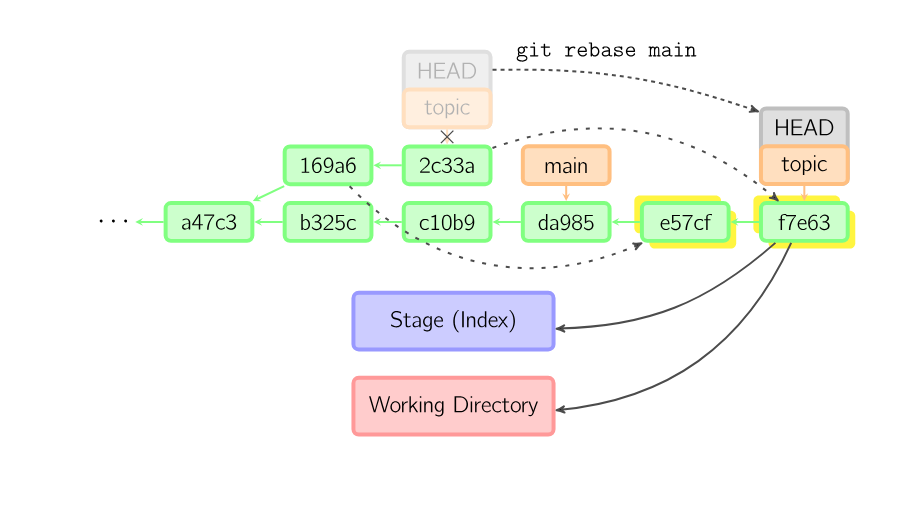最近研究了很久git,因为此前一直在使用git最简单的做法,即git add . -> git commit -> git push,直接在main分支上工作。学习了很多别人的项目后意识到这样完全不适合多人协作,而且对一些错误操作的容错率也很不理想。因此,我决定重新学习适合自己的git工作流,并记录下来。
本文适合有基础git知识的朋友阅读。我整合了三种适合个人项目和小型团队项目的工作流,并以脚本的形式提供。全文使用的都是
nushell脚本。
分支管理 #
通常,git和github的默认分支是main(master和main的区别是什么?),你的git如果不是以main为默认分支名,可以通过以下命令修改:
git config --global init.defaultBranch main对于一个极简的单人项目,如果项目没有构建、部署等需求(最常见的情况是作业文档、简单脚本等),那么项目仓库只有一个main分支是一个非常合理的事情,此时不要强求自己弄出多个分支,除了把自己弄得晕头转向外,不会从分支中获得过多的好处,因此不太建议。
对于一个相对正式的项目,如果主要由个人维护,那么可以在main分支之外开出一个dev分支,用于存放开发中的代码,在dev分支上完成开发后,将dev分支合并到main分支上。main分支上的代码总是稳定的,可以随时部署到生产环境,而dev分支上的代码是开发中的代码,可能不稳定,不应当用于构建和部署。
对于一个多人参与的、更为复杂的项目,仅有main和dev分支是不够的,多人在一个分支中工作会引入非常多的冲突,会导致混乱。此时我建议针对每个待开发的特性或故障修复开一个单独的分支(feat/xxx, fix/xxx, …),尽量确保同一个开发分支内只有一个成员或尽量少的成员。
下面将针对这三种工作流展开来讲。
提交代码(commit) #
提交代码在各种工作流中没有任何区别,下面直接给出脚本:
# Run `cm` without args when you want to commit. It'll stage all changes and show diff.
# After checking diff, you can run `cm` again with a commit message to actually commit.
export def cm [message?: string] {
# Only allow commit on main branch if there's only one main branch.
if ((current-branch) == "main" and (branch-count) > 1) {
print "⚠️ Do not commit on main branch!"
return
}
if ($message == null) {
git add .
print "📝 All changes are staged. Diff:"
git diff --cached --numstat
| lines | parse "{added}\t{removed}\t{file}"
| rename "+" "-" "file" | print
git diff --cached | bat --style=grid --color=always
} else {
git commit -am $message
}
}特别地,在多分支的工作流中,不能直接向main分支提交代码,main分支应当总是接受来自别的分支的合并。我的脚本的设计哲学是尽量把用户会犯的错误提前捕获,例如上面代码中当用户在当前分支为main、且有不止一个分支时提交代码会被直接拒绝,这有一点像Rust的理念。
极简工作流 #
如果只有一个main分支,commit后的工作就很直接:直接push到远程仓库即可。
export alias ps = git push -u origin HEAD事实上这种简单的工作流根本不适合用脚本,VS Code等IDE其实挺方便的。
双分支工作流 #
可以先创建一个dev分支:
export def dev [] {
if (has-branch 'dev') { # internal
git switch dev
} else {
input "📢 Create dev branch? (y/n): " | if ($in == "y") {
git switch main
git switch -c dev
}
}
}开发功能之前,你的dev分支应当先与远程的分支保持同步:
export alias pl = git pull --rebase接着你可以开始开发功能并提交代码。如果中途需要暂存到远端(比如要换个设备继续工作),只需要推送dev分支到远端即可。
功能开发完成并确保功能稳定后,可以合并到main分支:
# For some small personal projects, simply integrate current branch into main branch.
# Use it after you finish several commits on a branch.
# After this command, you may want to push both branches to remote.
export def inte [] {
let current = (current-branch)
if ($current == "main") {
print "❌ This action is not applicable to main branch. Switch to another branch first."
return
}
sync
git switch main
git merge $current --ff-only
$current
}这里sync是一个自定义的命令,我们先省略其实现细节,过后再讲;我们切换到main分支后,仅使用fast-forward方式合并(--ff-only选项),用于将dev分支比main分支更新的部分合并到main分支上。这里有一个示意图(注意,此图中stable充当main分支,main分支充当dev分支):

这种合并方式不会产生新的提交(commit),只会移动main分支的指针,使得提交记录更清晰。
合并后,可以将两个分支都推送到远程仓库。
团队开发多分支工作流 #
这个工作流参考了哔哩哔哩博主码农高天的视频,他讲得非常详细和易懂。
和前面两种最大的差别在于,我们假设你不是项目的拥有者/维护者(owner/maintainer),不能直接向主分支贡献代码,而是需要打开Pull Request,请求合并到主分支。(什么是Pull Request?)
Fork原代码仓库后,你可以创建一个特性分支(feat/xxx)来开发新特性,或者创建一个修复分支(fix/xxx)来修复bug。开发完成后,将这个分支推送到自己的远程仓库。
📢 注意!如果在你开发期间,原代码仓库(上游代码仓库)主分支有新的提交,你的分支将无法与上游代码仓库合并!
该怎么做呢?这将是本文的一个难点,先看代码:
# Sync latest changes from main branch, and corporate into current branch.
# Now current branch is: latest main branch -> current branch changes.
# After this command, you may want to push current branch and open a pull request.
export def sync [] {
if not (is-clean) {
print "⚠️ Working directory is not clean. Please commit or stash your changes: "
git-status
return
}
let current = (current-branch)
if ($current == "main") {
print "📢 You are on main branch. This action will only update main branch."
}
# Sync remote fork from its parent.
gh repo sync (git remote get-url origin)
# Update main branch from origin.
git switch main
git pull --rebase origin main
# Rebase changes onto our current branch.
git switch $current
git rebase main
}主要分三步走:
- 将原代码仓库(上游代码仓库)同步到你的Fork仓库中,这使用了
ghCLI,详见文档。
gh repo sync (git remote get-url origin)- 更新本地的
main分支到最新。
git switch main
git pull --rebase origin main- 将当前分支的更改重新应用到最新的 main 分支上,确保当前分支的更改是最新的。🚀
git switch $current
git rebase main这个变基的操作有一个示意图:

变基后,我们得到的分支如下(箭头表示先后顺序):
旧main分支 -> 新main分支提交 -> 当前分支提交完成后就可以把特性分支推送到自己的远程仓库,然后打开Pull Request请求合并到主分支了。
这已经是最完美了吗? #
显然不是,这只是一个小型团队的工作流模型,对于一个成熟的企业或组织,有着相当多的细节需要处理,例如权限管理、代码审查、CI/CD等,这些内容超出了本文的范围,也很难拿出一个通用的解决方案。
学习本文将是你从一个git初级用户迈向中级用户的关键一步,希望能对你有所帮助!
附:master还是main? #
前面已经提到过,因为种族歧视的原因,现在github中master和main将会长期共存。我编写了一个函数返回当前的主分支:
export def master-or-main [] {
if (git branch | lines | each { |it| $it | str trim | str replace '* ' '' } | any { |it| $it == "main" }) {
return "main"
} else {
return "master"
}
}我的脚本全文:这里。
我的下一篇 git 工作流的博文:这里。